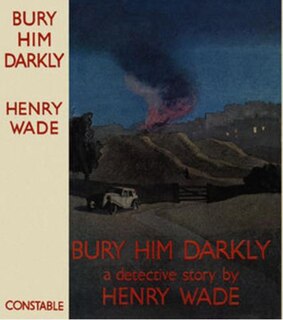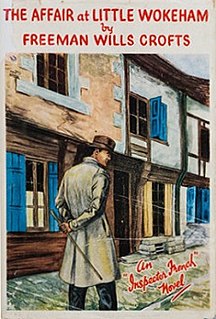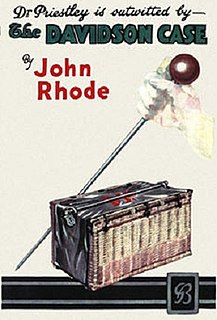Inspector Joseph French is a fictional British police detective created by Irish author Freeman Wills Crofts. French was a prominent detective from the Golden Age of Detective Fiction, appearing in twenty nine novels and a number of short stories between 1924 and 1957. The character was introduced in the 1924 novel Inspector French's Greatest Case, where he investigates a deadly diamond robbery in Hatton Garden. The series relied largely on puzzle mysteries.

No Friendly Drop is a 1931 mystery detective novel by the British writer Henry Wade. It was the second in a series of seven novels featuring the character of Inspector Poole, published during the Golden Age of Detective Fiction. It was released in the United States the following year by Brewer and Warren where it received positive reviews in the New York Herald Tribune and the New York Evening Post, with the latter describing it as "A superior detective story, depending more upon intrinsic interest in a logical plot than upon excitement and goriness for its hold on the reader".

Constable Guard Thyself is a 1934 mystery detective novel by the British writer Henry Wade. It was the third in a series of seven novels featuring the character of Chief Inspector Poole, although it was preceded by the 1933 short story collection Policeman's Lot in which seven of the twelve stories had featured Poole. After his more experimental novel Mist on the Saltings Wade returned to the traditional detective model.

Bury Him Darkly is a 1936 mystery detective novel by the British writer Henry Wade. It was the fourth in a series of seven novels featuring the character of Inspector Poole. Along with the following Poole novel, Lonely Magdalen, it marked a shift towards more realistic police procedurals that has been described as pioneering. Superintendent Fraser, who appeared in Wade's fist novel The Verdict of You All, also appears as one of the characters.

The Verdict of You All is a 1926 mystery detective novel by the British writer Henry Wade, his debut novel. Both this and his following novel The Missing Partners revolve around potential miscarriages of justice. It was published in the United States by Payson and Clarke in 1927. A success it launched his career as one of the prominent writers during the Golden Age of Detective Fiction. The title refers to the traditional question asked in court by a judge of the jury to establish whether they have reached a unanimous verdict.

Too Soon to Die is a 1953 mystery detective novel by the British writer Henry Wade. It was the sixth in a series of seven novels featuring the character of Inspector Poole, published during the Golden Age of Detective Fiction. It followed a thirteen year gap since the publication of the previous novel Lonely Magdalen.

Gold Was Our Grave is a 1954 mystery detective novel by the British writer Henry Wade. It was the seventh and last in a series of novels featuring the character of Inspector Poole, published during the Golden Age of Detective Fiction.

The Cask is a 1920 detective novel by the Irish-born writer Freeman Wills Crofts. His debut novel, it is considered his masterpiece. Long after the author's reputation had declined, this book was still hailed by critics as a cornerstone of the genre Crofts had been working as a railway engineer before writing the novel, but its success launched him as one of the leading writers of the Golden Age of Detective Fiction. He later went on to create the character of Inspector French of Scotland Yard who appeared in a long-running series of novels.

Enemy Unseen is a 1945 detective novel by Freeman Wills Crofts. It is the twenty fifth in his series of novels featuring Chief Inspector French, a prominent figure of the Golden Age of Detective Fiction. A review by Anthony Boucher in the San Francisco Chronicle noted it was "For the patient only, but for them a rewarding treasure."

The Affair at Little Wokeham is a 1943 detective novel by the Irish writer Freeman Wills Crofts. It is the twenty fourth in his series of novels featuring Inspector French, a prominent figure of the Golden Age of Detective Fiction. It was published in the United States under the alternative title of Double Tragedy.

Fear Comes to Chalfont is a 1942 detective novel by the Irish writer Freeman Wills Crofts. It is the twenty third in his series of novels featuring Inspector French, a prominent figure of the Golden Age of Detective Fiction. Like much of the author's work it combines a traditional mystery with a police procedural.

Antidote to Venom is a 1938 detective novel by the Irish-born novelist Freeman Wills Crofts. It is the eighteenth in his series of novels featuring Inspector French, a Scotland Yard detective known for his methodical technique. It was reissued in 2015 by the British Library Publishing as part of a group of crime novels from the Golden Age of Detective Fiction.

The Box Office Murders is a 1929 detective novel by the Irish-born writer Freeman Wills Crofts. It is the fifth in his series of novels featuring Inspector French, a prominent figure of the Golden Age of Detective Fiction. It was published in the United States the same year by Harper under the alternative title The Purple Sickle Murders.

Golden Ashes is a 1940 detective novel by the Irish writer Freeman Wills Crofts. It is the twentieth in his series of novels featuring Inspector French, a prominent investigator of the Golden Age of Detective Fiction.

Death in Harley Street is a 1946 detective novel by John Rhode, the pen name of the British writer Cecil Street. It is the forty third in his long-running series of novels featuring Lancelot Priestley, a Golden Age armchair detective. Several sources consider it to be the author's masterpiece.

A Village Afraid is a 1950 detective novel by the British writer Cecil Street, writing under the pen name of Miles Burton. It was part of a lengthy series of books featuring the detective Desmond Merrion and Inspector Arnold of Scotland Yard.

Dr. Priestley's Quest is a 1926 detective novel by John Rhode, the pen name of the British writer Cecil Street. It was the second appearance of the armchair detective Lancelot Priestley, who featured in a long-running series of novels during the Golden Age of Detective Fiction. It has been described as the first major detective novel by the author. In its relationship between Priestley and his secretary and future son-in-law Harold Merefield is shown the influence of Conan Doyle's Sherlock Holmes and Watson. Similarly, Inspector Hanslet of Scotland Yard fulfils a similar role to that of Lestrade.

The Murders in Praed Street is a 1928 detective novel by John Rhode, the pen name of the British writer Cecil Street. It features the fourth appearance of the armchair detective Lancelot Priestley, who figured in a long-running series of novels during the Golden Age of Detective Fiction.

Anything to Declare? is a 1957 detective novel by Freeman Wills Crofts. It is the twenty ninth and final entry in his series of novels featuring Inspector French, a prominent figure of the Golden Age of Detective Fiction. The author had been in poor health for much of the decade, and struggled to finish this book which was published a few weeks before his death.

The Davidson Case is a 1929 detective novel by John Rhode, the pen name of the British writer Cecil Street. It was the seventh appearance of the armchair detective Lancelot Priestley, who featured in a long-running series of novels during the Golden Age of Detective Fiction.



















